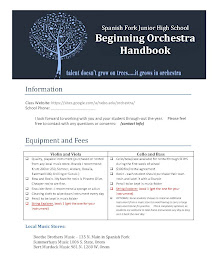After a year full of rehearsal and practice some of my school instruments look a little thrashed. Most of my school cellos are shared by 3 students - so they get a lot of use in a day. (Someday I hope to have enough cellos for all my students, but right now I’m about 40 short.) After our final concert I do an instrument cleaning day and get everything looking shiny.
It’s good for general maintenance to have all students clean their instruments at least once per year. We use spray bottles filled with distilled water and 1-2 tablespoons of white vinegar. I tell students to never spray ‘cleaner’ on directly on their instruments. We use a collection of bandannas I found in my classroom and students spray a little vinegar water on a bandanna to wipe down their instruments. They use a dry bandanna for buffing.
Recently I was able to tour the repair shop of a local music store, Summerhays Music in Orem, UT. www.smcorem.com I learned some maintenance tips I wish I would have known when I started teaching! These tips would have saved my program budget a lot of money. Summer is a great time to check instruments and do these simple steps to make sure instruments stay in good condition.
1. MINERAL OIL
Do you have any of those fine tuners that are super hard to turn? In my classroom I have a few cellos from the dark ages with tuners so stiff it hurts my fingers to try to use them. When instruments are cleaned you should unscrew the fine tuner and put a drop of mineral oil in the hole where the screw goes. This will ensure the fine tuner keeps working properly. I will be having students do this on our instrument cleaning day from now on. You can also use mineral oil to lubricate bass pegs/mechanism.
2. ENDPINS
I have a little epidemic going on in my orchestra. Students are constantly losing those little endpin bolts and we’ve had a few endpins go inside the cellos. I can’t stand it when that happens because it’s so frustrating to get those endpins back out! I once tried to get an endpin back in place with a back-scratcher…..doesn’t work. Inevitably I have to send those cellos to the repair shop to have them retrieve the endpin. At school I’ve just been wrapping masking tape around the end of cello endpins to keep them from going inside the cello. It doesn’t look great...but that was my quick fix.
At Summerhays I learned you can just go to a hardware store and buy bolts (size M8 1.25) that will screw right back on the endpins. They’re super cheap..and you can SUPER GLUE them in place so they never fall off. This is going to save my program some money for sure.
3. BRIDGES
A have quite a few cellos with warped bridges. I thought it was happening because the wood was bad, but I learned that the warping happens when the bridge is crooked. I have never consistently checked the bridges on all my instruments to make sure they are straight. This will now be part of my routine. The Summerhays repair shop taught me how to properly adjust the bridge. They said you do NOT loosen the strings to adjust the bridge (unless it needs major adjusting/placement). You brace your hands on the bridge and move/adjust from the top. You don’t try to move the feet...just the top of the bridge until it is 90 degrees.
4. WITTNER PEGS
I actually discovered these pegs a few years ago. I was wasting too much time trying to tune old cellos with ill-equipped pegs. When these Wittner pegs came out I loved them so much...I slowly started using my school budget to have these pegs put in all my school cellos. It is worth every penny! Saves a ton of time with tuning. When I start a class of 50+ beginners I have to be able to tune them all in 3-5 minutes. These pegs make it a breeze. It also helps students tune their own instruments with ease. I teach beginners how to tune about mid-way through the school year. I now rarely have a student who breaks a string.
5. OLD STRINGS
I’m guilty. There are cellos and basses at my school equipped with some ancient strings. At school I usually only replace strings when they break. I’ve never made room in my budget to replace old strings. I know some of my instruments would sound way better if I would just put on new strings.
Part of my summer maintenance will be to finally start replacing strings and keeping track of when new strings are put on. My inventory is currently organized in a google spreadsheet. I can type notes directly on my inventory regarding when strings have been replaced, what repairs have been done, etc. That way I can create a rotation to begin replacing strings without having to do all 50+ instruments at once.
At Summerhays I learned that it is best to purchase strings that are straight (not wound in a packet). This ensures the winding on the string lasts longer. The core and the winding of the string can deteriorate when the winding is bent and compromised. Buying local is ideal because you can buy strings that are straight. Summerhays has awesome low prices (even lower than online retailers) and stores all their strings straight.
I hope you find these tips useful as you spend time with your inventory at the end of the school year/beginning of the new school year.














